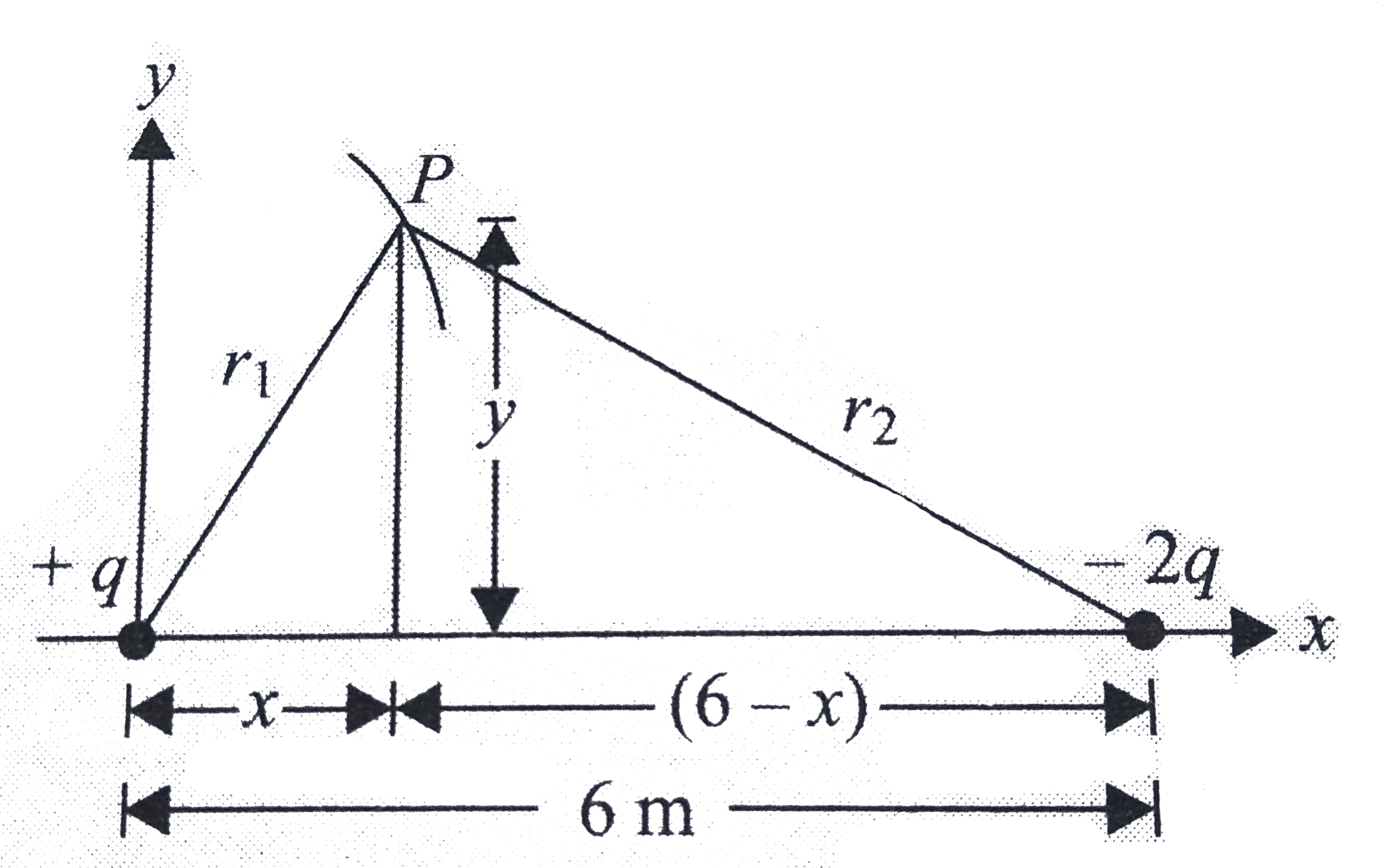Two monochromatic and coherent point sources of light are placed at a certain distance from each other in the horizontal plane. The locus of all those points in the horizontal plane which have constructive interference will be-
A hyperbola
family of hyperbola
family of straight lines
family of parabolas
The correct Answer is:B
To solve the problem of finding the locus of points in the horizontal plane that exhibit constructive interference from two coherent point sources of light, we can follow these steps:
1. Understanding Constructive Interference:
Constructive interference occurs when the path difference between the two waves arriving at a point is an integral multiple of the wavelength (λ). Mathematically, this condition can be expressed as:
|d1−d2|=nλ
where d1 and d2 are the distances from the point to the two sources, and n is an integer (0, 1, 2, ...).
2. Defining the Sources:
Let the two point sources be S1 and S2. We can denote their positions in the horizontal plane. For simplicity, assume S1 is at the origin (0, 0) and S2 is at (d, 0), where d is the distance between the two sources.
3. Choosing a Point in the Plane:
Consider a point P(x,y) in the horizontal plane. The distances from this point to the two sources can be calculated as:
d1=√x2+y2(distance to S1)
d2=√(x−d)2+y2(distance to S2)
4. Setting Up the Path Difference Condition:
According to the condition for constructive interference:
|d1−d2|=nλ
This leads to two cases:
- Case 1: d1−d2=nλ
- Case 2: d2−d1=nλ
5. Deriving the Equation:
For Case 1:
√x2+y2−√(x−d)2+y2=nλ
Squaring both sides and simplifying will yield a hyperbolic equation.
For Case 2:
√(x−d)2+y2−√x2+y2=nλ
Similarly, squaring and simplifying will also yield a hyperbolic equation.
6. Conclusion:
The locus of all points where constructive interference occurs is a family of hyperbolas. Each hyperbola corresponds to a different integer value of n.
Final Answer:
The locus of all points in the horizontal plane that exhibit constructive interference from the two coherent point sources is a family of hyperbolas.
Constructive interference occurs when the path difference between the two waves arriving at a point is an integral multiple of the wavelength (λ). Mathematically, this condition can be expressed as:
|d1−d2|=nλ
where d1 and d2 are the distances from the point to the two sources, and n is an integer (0, 1, 2, ...).
Let the two point sources be S1 and S2. We can denote their positions in the horizontal plane. For simplicity, assume S1 is at the origin (0, 0) and S2 is at (d, 0), where d is the distance between the two sources.
Consider a point P(x,y) in the horizontal plane. The distances from this point to the two sources can be calculated as:
d1=√x2+y2(distance to S1)
d2=√(x−d)2+y2(distance to S2)
According to the condition for constructive interference:
|d1−d2|=nλ
This leads to two cases:
- Case 1: d1−d2=nλ
- Case 2: d2−d1=nλ
For Case 1:
√x2+y2−√(x−d)2+y2=nλ
Squaring both sides and simplifying will yield a hyperbolic equation.
√(x−d)2+y2−√x2+y2=nλ
Similarly, squaring and simplifying will also yield a hyperbolic equation.
The locus of all points where constructive interference occurs is a family of hyperbolas. Each hyperbola corresponds to a different integer value of n.
The locus of all points in the horizontal plane that exhibit constructive interference from the two coherent point sources is a family of hyperbolas.
Topper's Solved these Questions
- WAVE OPTICSBOOK - ALLENCHAPTER - WAVE OPTICSEXERCISE - Exercise 2 (Brain Teasures)
22 Videos
- WAVE OPTICSBOOK - ALLENCHAPTER - WAVE OPTICSEXERCISE - Exercise 3 (Miscellaneous type Questions)
27 Videos
- WAVE OPTICSBOOK - ALLENCHAPTER - WAVE OPTICSEXERCISE - Example 15
1 Video
- UNIT & DIMENSIONS, BASIC MATHS AND VECTOR BOOK - ALLENCHAPTER - UNIT & DIMENSIONS, BASIC MATHS AND VECTOR EXERCISE - Exercise (J-A)
7 Videos
Similar Questions
Knowledge Check
A point charge +q, is placed at a distance d from an isolated conducting plane. The field at a point P on the other side of the plane is
Adirected perpendicular to the plane and away from the plane.Bdirected perpendicular to the plane but towards the plane.Cdirected radially away from the point charge.Ddirected radially towards the point charge.
A point charge +q is placed at a distance d from an isolated conducting plane. The field at a point P on the other side of plane is
View SolutionTwo electric charges qand−2q are placed at a distance 6 m apart on a horizontal plane. Find the locus of point on this plane where the potential has a value zero.
 .
.
View SolutionA point source of light is placed at a distance of 2f from a converging lens of focal length f. The intensity onteh other side of the lens is maximum at a distance
View SolutionStatement I: Two coherent point sources of light having no-zero phase difference are separated by a small distance. Then, on the perpendicular bisector of line segment joining both the point sources, constructive interference cannot be obtained.
Statement II: For two waves from coherent point sources to interfere constructively at a point, the magnitude of their phase difference at that point must be 2mπ (where m is non-negative integer).
View SolutionA ball is projected from a point in a horizontal plane with a velocity of 20 m/s at 30∘ with the horizontal. Coefficient of restitution is 0.8, then
View SolutionLocus of all points having same horizontal magnetic field on the magnetic map of earth is known as
View SolutionFour monochromatic and coherent sources of light, emitting waves in phase of wavelength λ, are placed at the points x = 0, d 2d and 3d on the x-axis. Then
View Solution